Inside, I've been wondering what to do for AHIQ. Yes,
What to do
For AHIQ?
Last time you saw my hourglasses project, it looked like this:
I thought I was off to a good start with these big brick shaped blocks, and I spent a long day earlier this month making one more...
...and one big word:
I was very happy with the word, and ok with the block, but at the end of the day I was feeling like things were on the wrong track. I was trying to combine two projects into one, but that wasn't working. So my first decision was to save the word for later and focus on the hourglasses for now.
Now what? One day I was looking at the patio stones, and I thought it would be good to sew my bricks together into big squares, and still have the narrow green sashing I wanted before. But then I never got around to it.
Then last week I started my new Aunt Millie project, and that whole thing just fell together so naturally. Most of the quilt is already cut. Yesterday I was admiring it, and I really liked the simple and light feel that it has.
Aha! Light. I realized right then that my hourglasses were too dense and heavy. And cumbersome. Thank goodness I didn't sew the blocks together into even heavier sections! In fact, I realized that heaviness has been my problem with this quilt from almost the very beginning. I tried to change the construction method, I tried to lighten up the colours, but nothing really helped.
What I needed were smaller blocks, with wide sashing to let them breathe. I cut my big blocks in half:
And as soon as I thought of wide sashing, I thought of this quilt, Stacked Bricks, by Gee's Bend quilter Nettie Young. Back in January Ann shared this link as part of the kick off for her Chinese Coins improv challenge, and it really spoke to me. I did some math and thought about fabrics, but the time wasn't right. I've found, though, that once I start thinking about a quilt, eventually it will see the light of day, in one form or another. My plan is to use these blocks, in that layout.
My existing blocks were about 13" square, and I wanted to get them down to about 10.5" unfinished. I tightened up all the rows, and then gave them a final trim around. They're not totally exciting, but they work.
I'm banking more on the full effect at the end, rather than the individual blocks.
But, I also still had another setting idea to try for the hourglasses. It is a lot easier to make the smaller blocks! And I'm very pleased with this layout. This one is weighted to the dark fabrics...
...and this one is weighted to the light fabrics. I like them both.
I also started to take more care matching the fabrics. When I started I had the idea that it had to be random. Now I've realized that the main thing is not to get bogged down in decision making, and just look for nice combinations as I go along. I think I finally have some traction on this quilt!
Riley Blake made this printed gingham in 11 colours, and I have them all. I used the red and orange in MUQ#1, Picnic, and the yellow in MUQ#2, Sunshine. So, I guess there is still room to run with these for a while. Although, there is a brown gingham and a navy gingham that are both pretty ugly. But, that is a challenge for another time!
Right now, please check out all the other improv links for AHIQ this month. And if you are inspired by the next challenge, anyone can join in!














